Pergola vs. Arbor: What’s the difference?
A few simple landscaping structures like pergolas and arbors may be able to take your yard to the next level. They can provide shade, aesthetic interest, and even help your with your garden game. Some people use the words pergola and arbor interchangeably, while others think maybe there’s just a regional difference when it comes to what word to use. Others take the “I know it when I see it” approach to defining the two. Here, we’ll explain what each is and how it is used, to allow you to make the best decision for your yard and better communicate with your yard designer about what you want.
What is an arbor?
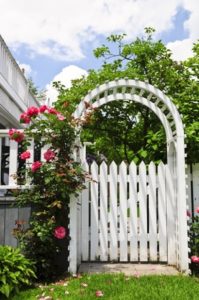 An arbor is defined by Merriam-Webster as “a shelter of vines or branches or of latticework covered with climbing shrubs or vines.” It seems, then, that arbors and plants are intertwined – literally. However, while an arbor serves as a great palate for coaxing vines and climbing plants to create a wall or archway, it can also simply be a freestanding structure itself. In fact, that’s one of the hallmarks of an arbor: it’s freestanding. Rather than jutting out from a house or garage, an arbor usually shades a gate, walkway, or even a bench. Another defining characteristic of an arbor is that it is often covered with lattice. While the sides of an arbor may look somewhat open if there is no plant covering, at its heart, an arbor is able to support growing plants.
An arbor is defined by Merriam-Webster as “a shelter of vines or branches or of latticework covered with climbing shrubs or vines.” It seems, then, that arbors and plants are intertwined – literally. However, while an arbor serves as a great palate for coaxing vines and climbing plants to create a wall or archway, it can also simply be a freestanding structure itself. In fact, that’s one of the hallmarks of an arbor: it’s freestanding. Rather than jutting out from a house or garage, an arbor usually shades a gate, walkway, or even a bench. Another defining characteristic of an arbor is that it is often covered with lattice. While the sides of an arbor may look somewhat open if there is no plant covering, at its heart, an arbor is able to support growing plants.
An arbor can come in a traditional arched variety or have a flat top, which is another reason they are often confused with the traditionally-flat pergola. Often, an arbor is only a few feet in width, making them ideal entry ways or focal points, but less useful for dining spaces or outdoor rooms.
What is an arbor used for?
An arbor is used as a design element, but also for gardening purposes. An arbor can add 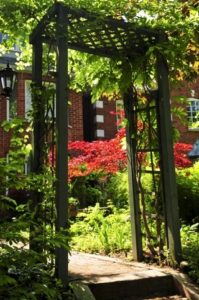 height to a location where you may not have any tall structures. It does this two ways: an arbor is almost always tall enough for someone to walk beneath (a minimum of about seven feet tall), and an arbor allows plants to grow over the lattice work on the sides and top, creating plant height in your garden. This also allows you to grow plants that need additional structure to reach their full potential. Arbors can also create a shaded walkway – as long as your plants are in full bloom!
height to a location where you may not have any tall structures. It does this two ways: an arbor is almost always tall enough for someone to walk beneath (a minimum of about seven feet tall), and an arbor allows plants to grow over the lattice work on the sides and top, creating plant height in your garden. This also allows you to grow plants that need additional structure to reach their full potential. Arbors can also create a shaded walkway – as long as your plants are in full bloom!
Arbors are often used as a covering for gates as well. Instead of shielding the gate from the elements, though, it highlights the way into or out of your garden or yard, adding charm and possibly balancing out your yardscape.
What is a pergola?
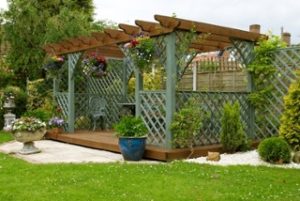 Unlike an arbor, a pergola is not often freestanding. It is usually attached to or placed right next to a home or other structure. Think of it more like an open overhang with supports – usually four columns. It is a much more substantial structure than an arbor and can be used to create long, covered walkways or overhangs.
Unlike an arbor, a pergola is not often freestanding. It is usually attached to or placed right next to a home or other structure. Think of it more like an open overhang with supports – usually four columns. It is a much more substantial structure than an arbor and can be used to create long, covered walkways or overhangs.
Like an arbor, a pergola can be used to grow plants, and many people enjoy winding vines through the pergola’s open roof structure. A pergola is usually at least partially open on the sides. A small part may be covered with lattice to help vertical plants, but the purpose of a pergola is to have an open space that is defined. The side columns may also be used to grow plants, though, from grapevines to bougainvillea.
What is a pergola used for?
Because a pergola is attached to a home, and therefore can be much larger in size than an 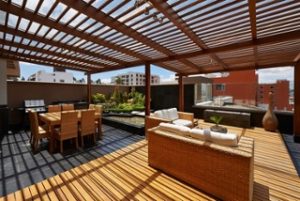 arbor, it is perfect for creating outdoor rooms. Pergolas often shade decks or patios, creating a comfortable space even in the middle of the afternoon. As the sun moves across the sky, the pergola’s open roof can deliver different levels of shade, but always leave you with partial sun. A pergola is also great for defining space, such as an outdoor kitchen or eating area, if you have a large deck or space that cannot be carved out via paver stones or other terrain.
arbor, it is perfect for creating outdoor rooms. Pergolas often shade decks or patios, creating a comfortable space even in the middle of the afternoon. As the sun moves across the sky, the pergola’s open roof can deliver different levels of shade, but always leave you with partial sun. A pergola is also great for defining space, such as an outdoor kitchen or eating area, if you have a large deck or space that cannot be carved out via paver stones or other terrain.
Although a pergola traditionally has an open rafter structure, which never completely blocks out the sun, many modern pergolas employ a retractable screen or protective cover as well, offering additional shade and even some protection from rain. Accessories like lights and side curtains can further help define the space within a pergola as a real outdoor room.
Special bonus: What is a trellis and how is it different than a pergola or arbor?
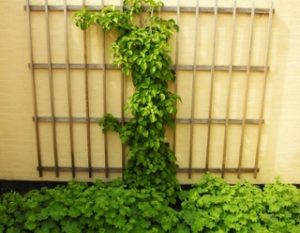 While we’re talking about structures that can support vines, you may wonder where the trellis fits in. Although a trellis can be used horizontally or vertically, it is really distinct from an arbor or pergola. A trellis is made of lattice, which can also be used on an arbor. Really, a trellis is defined as a structure that is made out of several pieces of woven lattice and used to support plants. While pergolas and arbors can be used to show off those climbing vines, plants are not a distinctive characteristic of either, but they are necessary with a trellis. A trellis can be installed against the wall of the building, freestanding, or horizontally supported with posts, but it will always be used for plant growth.
While we’re talking about structures that can support vines, you may wonder where the trellis fits in. Although a trellis can be used horizontally or vertically, it is really distinct from an arbor or pergola. A trellis is made of lattice, which can also be used on an arbor. Really, a trellis is defined as a structure that is made out of several pieces of woven lattice and used to support plants. While pergolas and arbors can be used to show off those climbing vines, plants are not a distinctive characteristic of either, but they are necessary with a trellis. A trellis can be installed against the wall of the building, freestanding, or horizontally supported with posts, but it will always be used for plant growth.
If you need help deciding which landscaping structures will work the best in your yard, or you are ready to move forward with an arbor or pergola, give us a call or fill out our handy-dandy contact form today!
To order fence parts or schedule professional installation,
call 800-431-4303 or contact us online!

